Abstract
Research has revealed the phenomenon of conditioned suppression in which the rate of responding is reduced during a stimulus that is paired with noncontingent shock. The present study replicated this procedure, but used noncontingent positive reinforcers instead of the aversive shock. The lever-pressing responses of rats were reinforced with food or water. While the rats were responding, a stimulus was occasionally presented and paired with the delivery of a noncontingent positive reinforcer, which was either food, water, or brain stimulation for different rats. The result was a reduction in the rate of responding during the conditioned stimulus. This finding shows that conditioned suppression occurs during a signal for reinforcing as well as aversive stimuli.
Full text
PDF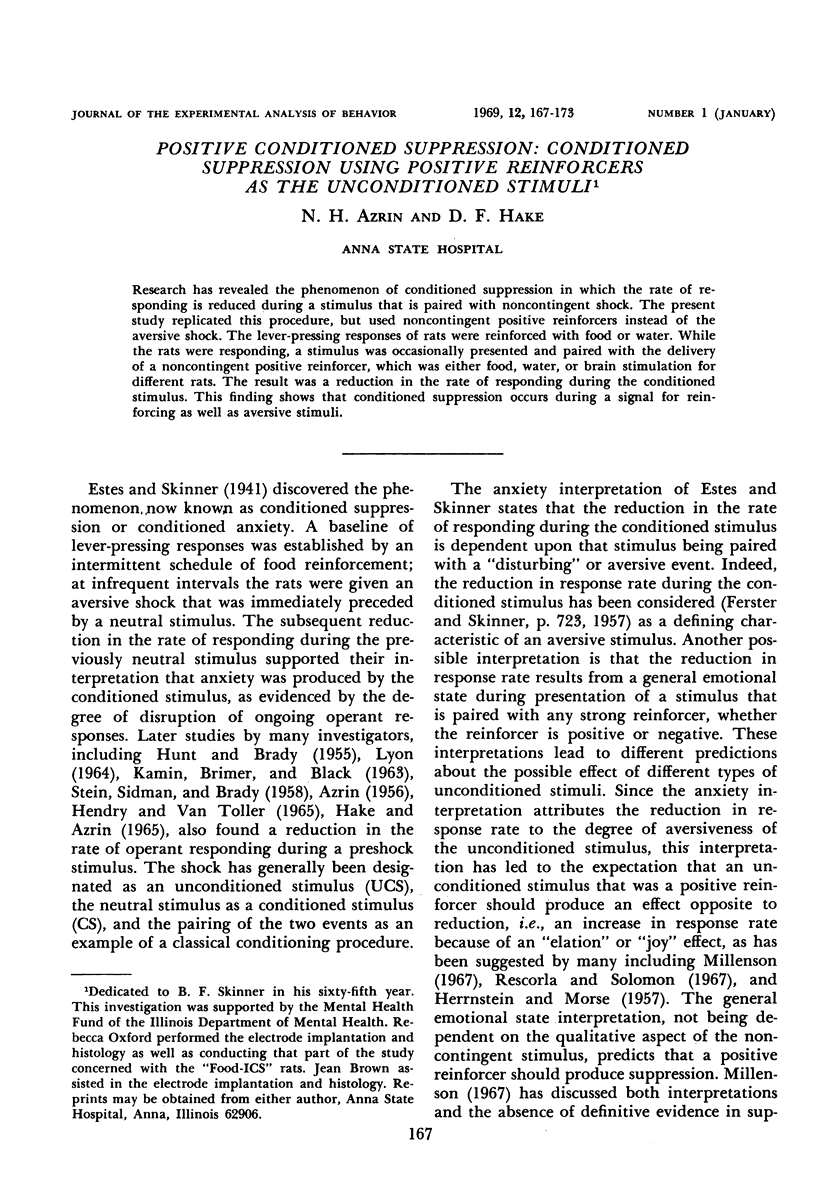
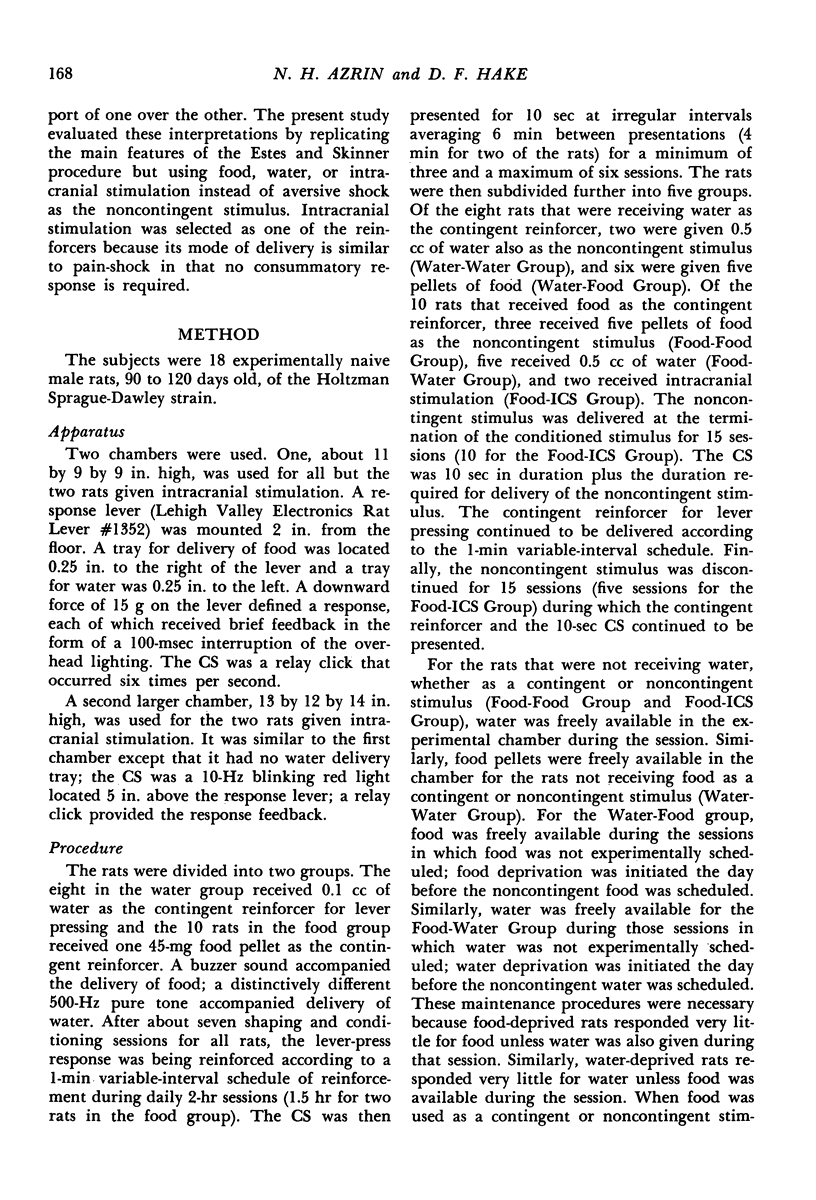
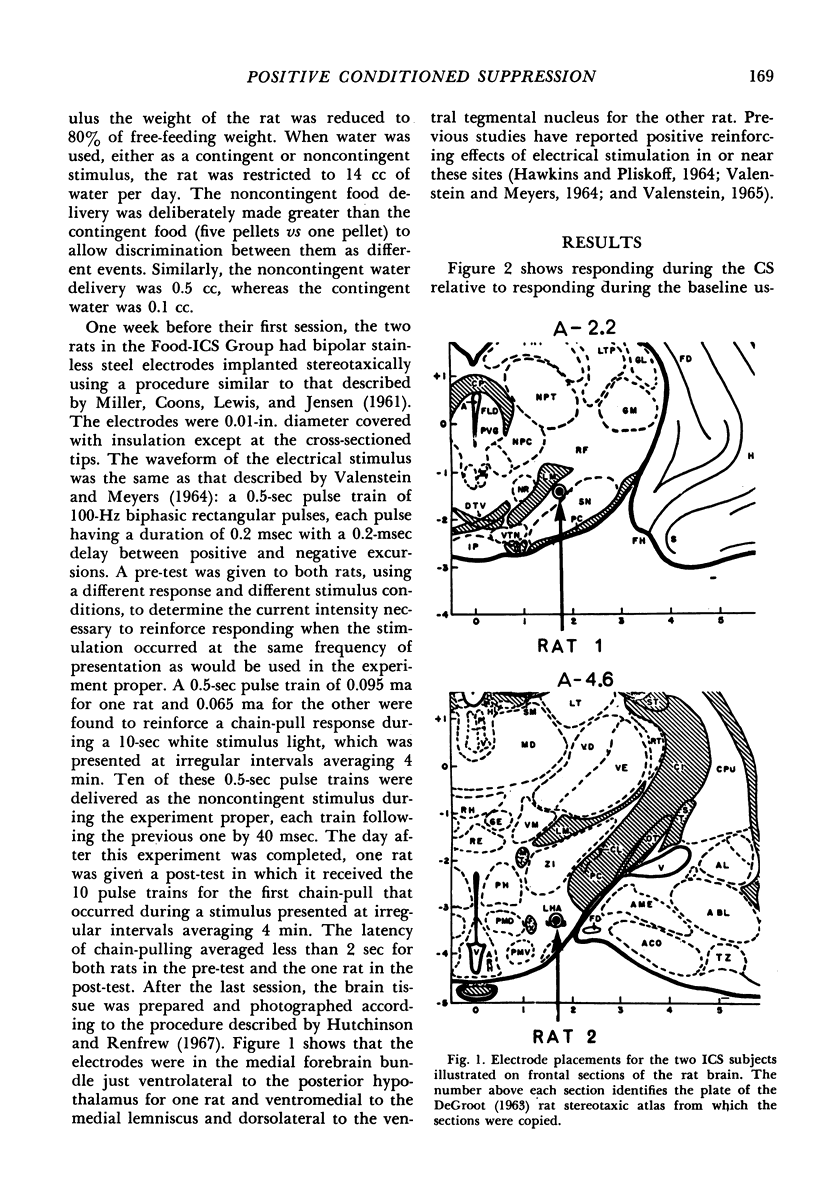
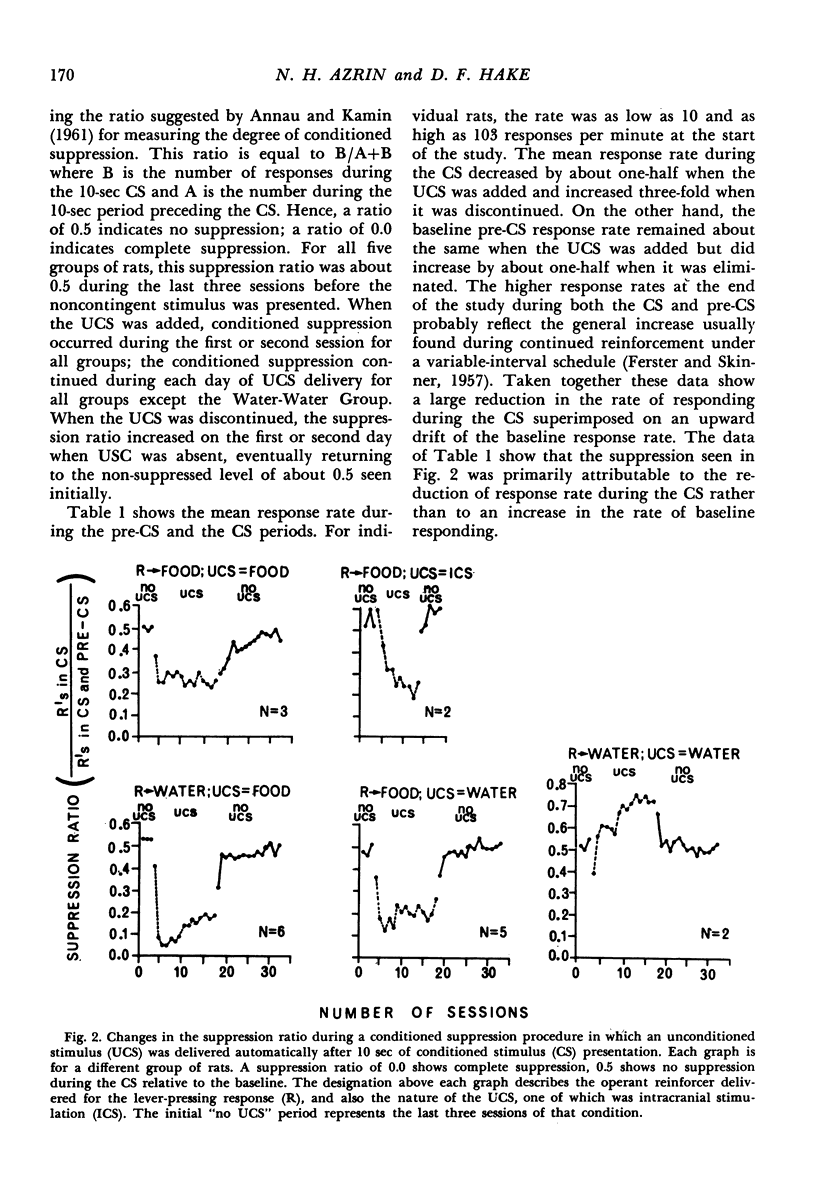
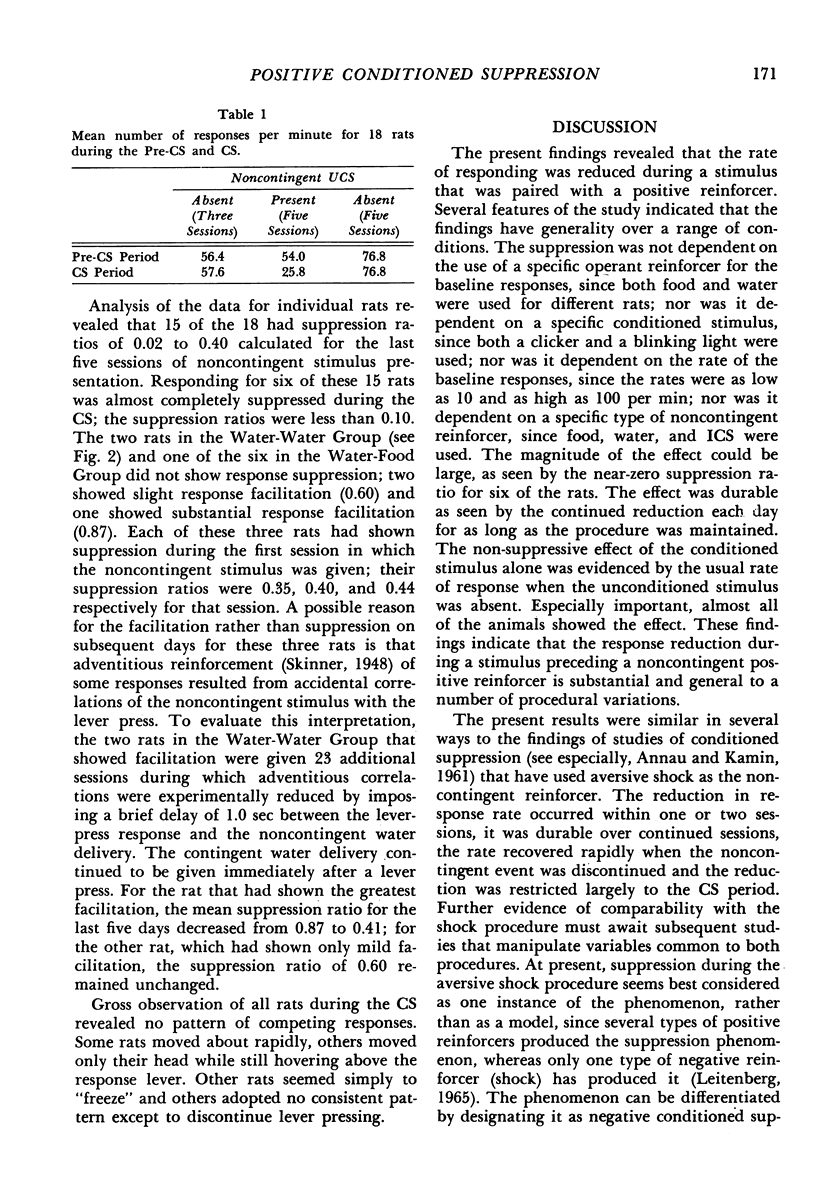
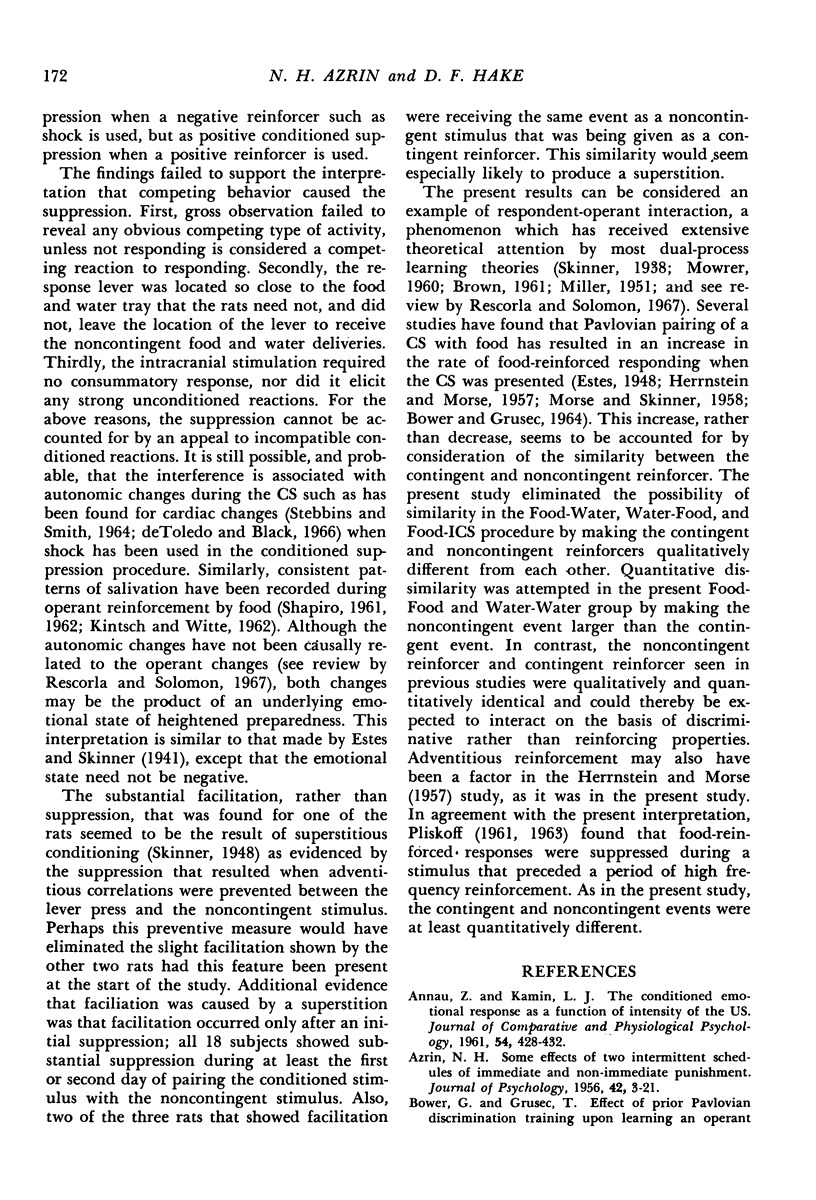
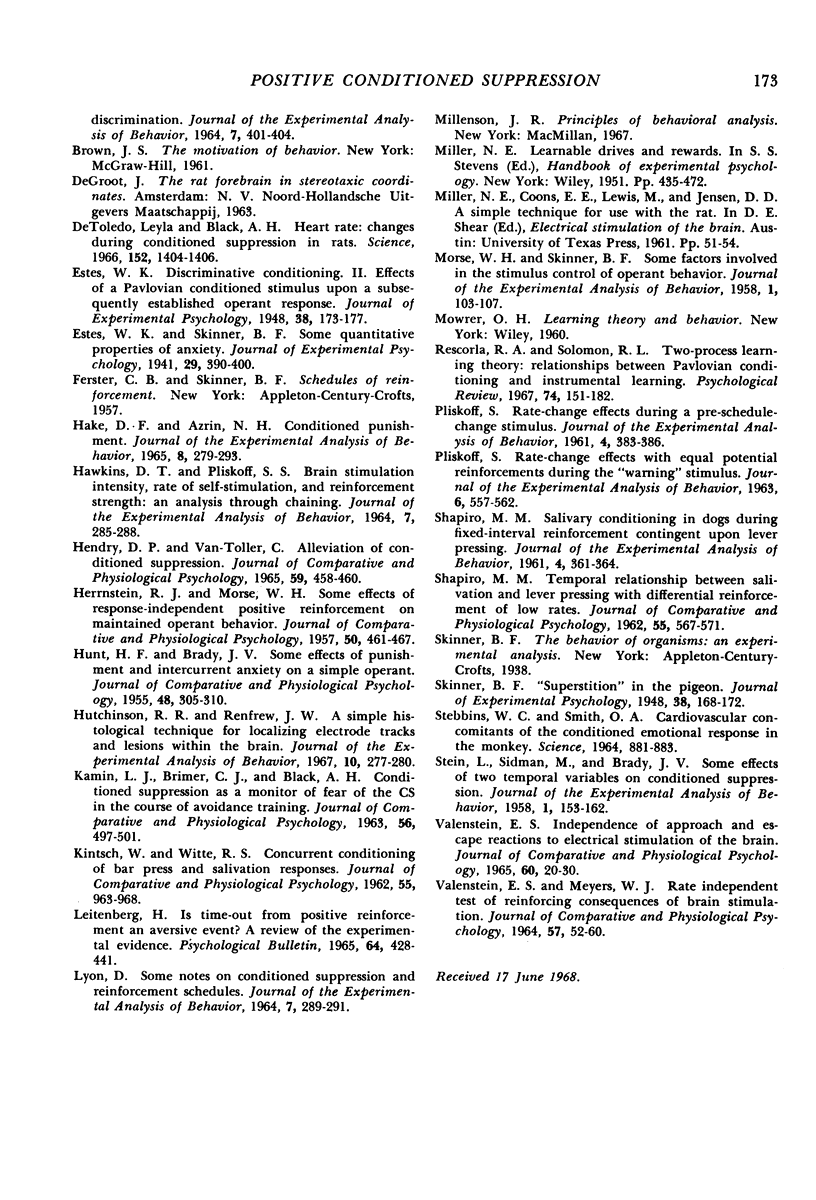
Selected References
These references are in PubMed. This may not be the complete list of references from this article.
- ANNAU Z., KAMIN L. J. The conditioned emotional response as a function of intensity of the US. J Comp Physiol Psychol. 1961 Aug;54:428–432. doi: 10.1037/h0042199. [DOI] [PubMed] [Google Scholar]
- BOWER G., GRUSEC T. EFFECT OF PRIOR PAVLOVIAN DISCRIMINATION TRAINING UPON LEARNING AN OPERANT DISCRIMINATION. J Exp Anal Behav. 1964 Nov;7:401–404. doi: 10.1901/jeab.1964.7-401. [DOI] [PMC free article] [PubMed] [Google Scholar]
- De Toledo L., Black A. H. Heart rate: changes during conditioned suppression in rats. Science. 1966 Jun 3;152(3727):1404–1406. doi: 10.1126/science.152.3727.1404. [DOI] [PubMed] [Google Scholar]
- HAKE D. F., AZRIN N. H. CONDITIONED PUNISHMENT. J Exp Anal Behav. 1965 Sep;8:279–293. doi: 10.1901/jeab.1965.8-279. [DOI] [PMC free article] [PubMed] [Google Scholar]
- HAWKINS T. D., PLISKOFF S. S. BRAIN-STIMULATION INTENSITY, RATE OF SELF-STIMULATION, AND REINFORCEMENT STRENGTH: AN ANALYSIS THROUGH CHAINING. J Exp Anal Behav. 1964 Jul;7:285–288. doi: 10.1901/jeab.1964.7-285. [DOI] [PMC free article] [PubMed] [Google Scholar]
- HENDRY D. P., VAN-TOLLER C. ALLEVIATION OF CONDITIONED SUPPRESSION. J Comp Physiol Psychol. 1965 Jun;59:458–460. doi: 10.1037/h0022051. [DOI] [PubMed] [Google Scholar]
- HERRNSTEIN R. J., MORSE W. H. Some effects of response-independent positive reinforcement on maintained operant behavior. J Comp Physiol Psychol. 1957 Oct;50(5):461–467. doi: 10.1037/h0041506. [DOI] [PubMed] [Google Scholar]
- HUNT H. F., BRADY J. V. Some effects of punishment and intercurrent anxiety on a simple operant. J Comp Physiol Psychol. 1955 Aug;48(4):305–310. doi: 10.1037/h0042529. [DOI] [PubMed] [Google Scholar]
- Hutchinson R. R., Renfrew J. W. A simple histological technique for localizing electrode tracks and lesions within the brain. J Exp Anal Behav. 1967 May;10(3):277–280. doi: 10.1901/jeab.1967.10-277. [DOI] [PMC free article] [PubMed] [Google Scholar]
- KINTSCH W., WITTE R. S. Concurrent conditioning of bar press and salivation responses. J Comp Physiol Psychol. 1962 Dec;55:963–968. doi: 10.1037/h0046131. [DOI] [PubMed] [Google Scholar]
- LYON D. O. SOME NOTES ON CONDITIONED SUPPRESSION AND REINFORCEMENT SCHEDULES. J Exp Anal Behav. 1964 Jul;7:289–291. doi: 10.1901/jeab.1964.7-289. [DOI] [PMC free article] [PubMed] [Google Scholar]
- Leitenberg H. Is time-out from positive reinforcement an aversive event? A review of the experimental evidence. Psychol Bull. 1965 Dec;64(6):428–441. doi: 10.1037/h0022657. [DOI] [PubMed] [Google Scholar]
- MORSE W. H., SKINNER B. F. Some factors involved in the stimulus control of operant behavior. J Exp Anal Behav. 1958 Jan;1:103–107. doi: 10.1901/jeab.1958.1-103. [DOI] [PMC free article] [PubMed] [Google Scholar]
- PLISKOFF S. S. RATE-CHANGE EFFECTS WITH EQUAL POTENTIAL REINFORCEMENTS DURING THE "WARNING" STIMULUS. J Exp Anal Behav. 1963 Oct;6:557–562. doi: 10.1901/jeab.1963.6-557. [DOI] [PMC free article] [PubMed] [Google Scholar]
- PLISKOFF S. Rate-change effects during a pre-schedule-change stimulus. J Exp Anal Behav. 1961 Oct;4:383–386. doi: 10.1901/jeab.1961.4-383. [DOI] [PMC free article] [PubMed] [Google Scholar]
- Rescorla R. A., Solomon R. L. Two-process learning theory: Relationships between Pavlovian conditioning and instrumental learning. Psychol Rev. 1967 May;74(3):151–182. doi: 10.1037/h0024475. [DOI] [PubMed] [Google Scholar]
- SHAPIRO M. M. Salivary conditioning in dogs during fixed-interval reinforcement contingent upon lever pressing. J Exp Anal Behav. 1961 Oct;4:361–364. doi: 10.1901/jeab.1961.4-361. [DOI] [PMC free article] [PubMed] [Google Scholar]
- SHAPIRO M. M. Temporal relationship between salivation and lever pressing with differential reinforcement of low rates. J Comp Physiol Psychol. 1962 Aug;55:567–571. doi: 10.1037/h0044726. [DOI] [PubMed] [Google Scholar]
- STEBBINS W. C., SMITH O. A., Jr CARDIOVASCULAR CONCOMITANTS OF THE CONDITIONED EMOTIONAL RESPONSE IN THE MONKEY. Science. 1964 May 15;144(3620):881–883. doi: 10.1126/science.144.3620.881. [DOI] [PubMed] [Google Scholar]
- Stein L., Sidman M., Brady J. V. Some effects of Two Temporal Variables on Conditioned Suppression. J Exp Anal Behav. 1958 Apr;1(2):153–162. doi: 10.1901/jeab.1958.1-153. [DOI] [PMC free article] [PubMed] [Google Scholar]
- VALENSTEIN E. S. INDEPENDENCE OF APPROACH AND ESCAPE REACTIONS TO ELECTRICAL STIMULATION OF THE BRAIN. J Comp Physiol Psychol. 1965 Aug;60:20–30. doi: 10.1037/h0022299. [DOI] [PubMed] [Google Scholar]
- VALENSTEIN E. S., MEYERS W. J. RATE-INDEPENDENT TEST OF REINFORCING CONSEQUENCES OF BRAIN STIMULATION. J Comp Physiol Psychol. 1964 Feb;57:52–60. doi: 10.1037/h0048638. [DOI] [PubMed] [Google Scholar]


